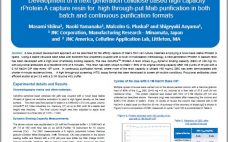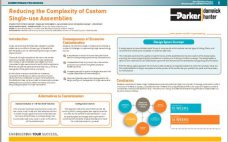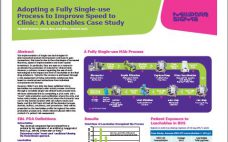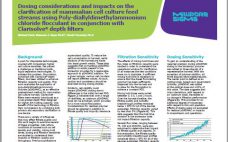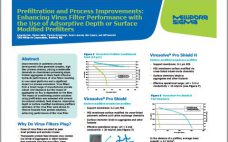Antibody-mediated haemolysis is a hard-to-predict phenomenon with potentially severe consequences. It is mediated by naturally-occurring anti-A and anti-B immunoglobulin isoagglutinins, which are present in plasma, blood, and several derived products, including IVIG produced by plasma fractionation. Prometic Bioseparations have developed an affinity chromatography resin for the removal of isoagglutinins from plasma and plasma derived products, such as IVIG. The resins, IsoClear A and IsoClear B, can clear isoagglutinins from a titre of 1/32 down to negative agglutination using a load…
Downstream Processing
Development of a Next Generation Cellulose-Based High Capacity rProtein A Capture Resin for High Throughput MAb Purification in Both Batch and Continuous Purification Formats
A new product development approach will be described for the affinity capture of Mab’s from cell culture materials employing a novel base stable rProtein A ligand. Using a stable cellulose base bead with excellent flow properties coupled with a novel immobilization methodology, a next generation rProtein A capture resin has been developed with a high level of antibody binding capacity. The new Cellufine™ rProtein A resin shows C20% dynamic binding capacity (DBC) of >50 mg/ mL with polyclonal antibodies at…
Beta Cyclodextrin Derivatives as Protein Aggregation Modulators
Protein aggregation is the major challenge encountered during manufacturing, storage and transportation of biopharmaceuticals (1,2). The objective was to evaluate the effect of two ßcyclodextrins derivatives: (KLEPTOSE® HPB hydroxypropyl-ß-cyclodextrin, with MS=0.65) and (KLEPTOSE® HP hydroxypropyl-ß-cyclodextrin, with MS=0.9) on two biologic drugs (Infliximab and Etanercept) aggregation using high-throughput formulation screening (iFormulate™) and nanoDSF (Differential Scanning Fluorimetry) (3,4). Preliminary results demonstrate that KLEPTOSE® HPB BioPharma hydroxypropyl-ß-cyclodextrin and KLEPTOSE® HP BioPharma hydroxypropyl-ß-cyclodextrin at high molarity (200 mM) are efficient tools in modulating Infliximab…
A Scalable Immobilized Metal Affinity Chromatography Resin for Process Purification
Downstream process purification of proteins requires a resin with optimized bead size for ideal pressure/flow properties and decent dynamic binding capacity (DBC) that provides production efficiencies and good process economics. Our newly developed metal chelate affinity resin — Nuvia™ IMAC — provides the mechanical strength, pore structures, ligand density, and particle size distribution required for an operation run at 300 cm/hr with a DBC of > 40 mg/ml at < 2 bar column backpressure. Protein purification can efficiently be scaled…
Reducing the Complexity of Custom Single-Use Assemblies
Single-use technology (SUT) has been adopted on a global scale since its introduction 20 years ago. Its benefits are well-recognized, and it is a key enabling technology in today’s biopharm world. Thousands of single-use products are now on the market and entire processes are being run in single-use systems. Historically, end users have been encouraged to produce ‘customized’ single-use solutions for each individual application. While this can give the user exactly what they want, it can be at the expense…
Adopting a Fully Single-use Process to Improve Speed to Clinic: A Leachables Case Study
The implementation of single-use technologies for pharmaceutical product development continues to gain momentum; this trend is due to the advantages of increased flexibility, speed of implementation and lower capital investment. In particular, they are seen as a means to accelerate the production of material for clinical trials. However, a primary concern regarding the use of such technologies is the impact and level of leachables in the final drug substance. Typically this concern is addressed through a risk assessment utilizing extractable…
Efficient Virus Clearance Across the MilliporeSigma Downstream Purification Portfolio
The downstream purification process of any biologic has several objectives: purity, yield, and safety for humans or animals. A critical component of safety assurance is reducing virus to levels that meet stringent regulatory requirements. Virus reduction can be achieved through multiple complementary approaches and most processes rely on a combination of technologies that are designed primarily to achieve purification targets, but may also offer opportunities for virus reduction. The purpose of this project was to establish capabilities for producing a…
Dosing Considerations and Impacts on the Clarification of Mammalian Cell Culture Feed Streams Using Poly-diallyldimethylammonium Chloride Flocculant in Conjunction with Clarisolve® Depth Filters
pDADMAC pretreatment of mammalian cell culture, coupled with Clarisolve® depth filters, provides for an effective pretreatment method by shifting the particle size distribution towards larger particles which can then be ‘matched’ to a graded depth filter designed for higher solids loading. Flexibility in filtration performance around pDADMAC dosing, flux rates, mixing hold times, and the variability in cell culture harvests provides for a robust clarification platform. Additionally, utilizing Clarisolve® filters for direct harvests, allows for a more compressed clarification train,…
Prefiltration and Process Improvements: Enhancing Virus Filter Performance with the Use of Adsorptive Depth or Surface Modified Prefilters
Improvements in upstream process development often generate complex, high titer process streams, placing considerable demands on downstream processing steps. Protein aggregates in these feeds influence hydraulic performance of virus filters resulting in over-sized platforms and a significant impact on process economics. Virus filters from a broad range of manufactures provide robust viral clearance but the impact of aggregates on flux is dependent on the filter. The impact of conditioning protein solutions using prefiltration was assessed with several monoclonal antibody feed…
High Viscosity Tangential Flow Filtration (TFF) Applications
Current trends in the bioprocessing industry are driving mAb and plasma producers to formulate at higher protein concentrations. As a result, formulating using tangential flow filtration (TFF) may be limited in reaching these concentrations due to high pressures caused by highly viscous feed streams. Filtration devices used during processing have to be optimized in order to handle both high viscosity and pressures while maintaining high flux and excellent product recovery. In this study, a family of filtration devices was evaluated…


